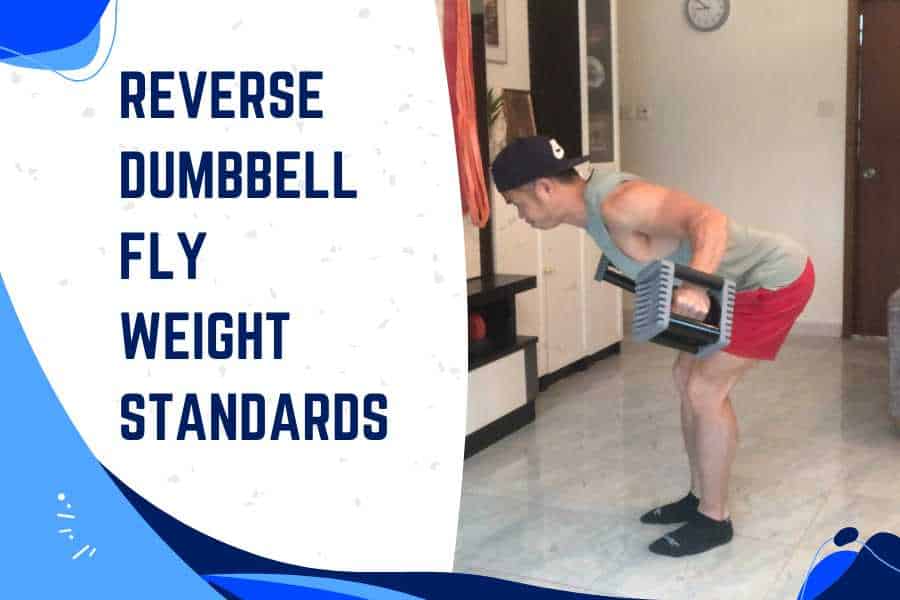Gaining the full benefits from doing reverse flyes using dumbbells requires you to lift the correct amount of weight. However, this can vary greatly between individuals. Below, are reverse dumbbell fly weight standards for you to benchmark your performance.
A good reverse dumbbell curl for the average male beginner is around 5% of body weight for a single repetition. In contrast, intermediates and advanced lifters should be able to lift around 45% and 75% of their body weight for 1 rep, respectively.
The weight standards in this post will help you determine what is a respectable weight to be lifting based on your gender, body weight, and training experience.
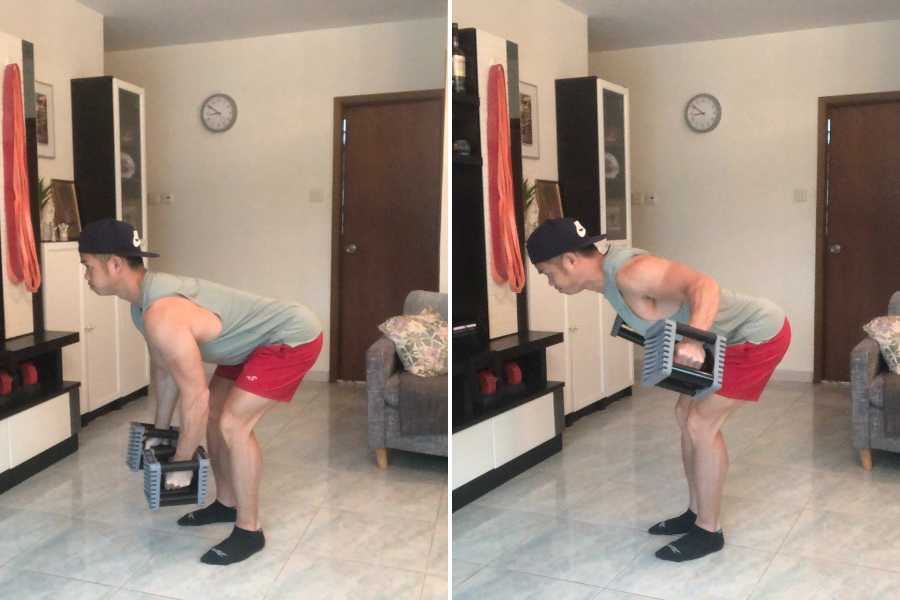
- How To Use These Weight Standards
- Beginner Dumbbell Reverse Fly Weight Standards
- Intermediate Dumbbell Reverse Fly Weight Standards
- Advanced Dumbbell Reverse Fly Weight Standards
- How Good Is Your Dumbbell Reverse Fly Vs Others?
- 5 Reasons Why Your Dumbbell Reverse Fly Strength Is Below Average
- Other Weight Standards For Dumbbell Reverse Fly Muscles
- Conclusion
How To Use These Weight Standards

1) Determining your training level:
- Beginners have practiced the reverse fly for 1-12 months.
- Intermediates have practiced the reverse fly for 12-36 months.
- Advanced lifters have practiced the reverse fly for 4 years or more.
2) Choosing your rep range:
The weight standards are given for:
- 1-rep max (1RM)- this is the maximum amount of weight you can lift for a single repetition. It’s often used as a strength standard.
- 6-10 working reps- this is generally considered to be the ideal rep range for building muscle.
3) Selecting your gender and body weight:
- Average reverse fly weight standards are revealed for common body weights.
- Male reverse fly weight standards are given.
- Females can use a 60% conversion (multiply the weight standard by 0.60).
4) Reading the charts:
- Weight standards are given as lbs on the top and kg on the bottom.
- If you’re reverse flying at or above the weight standard for your given training level, body weight, and gender, then you are lifting a respectable amount of weight.
Beginner Dumbbell Reverse Fly Weight Standards
Here’s how much weight you should be lifting on the dumbbell reverse fly as a beginner:
| Bodyweight | 1-rep max | 6-rep max | 7-rep max | 8-rep max | 9-rep max | 10-rep max |
|---|---|---|---|---|---|---|
| 120lb 54kg | 4lb 2kg | 3lb 2kg | 3lb 1kg | 3lb 1kg | 3lb 1kg | 3lb 1kg |
| 150lb 68kg | 8lb 4kg | 7lb 3kg | 7lb 3kg | 6lb 3kg | 6lb 3kg | 6lb 3kg |
| 200lb 91kg | 16lb 7kg | 13lb 6kg | 13b 6kg | 13lb 6kg | 12lb 6kg | 12lb 5kg |
| 250lb 113kg | 24lb 11kg | 20lb 9kg | 20lb 9kg | 20lb 9kg | 19lb 8kg | 18lb 8kg |
| 300lb 136kg | 30lb 14kg | 25lb 11kg | 25lb 11kg | 25lb 11kg | 23lb 11kg | 22lb 10kg |
Generally speaking, beginners should be able to dumbbell reverse fly 3 to 10% of their body weight for a single repetition (1-rep max).
Intermediate Dumbbell Reverse Fly Weight Standards
Here’s how much weight you should be lifting on the dumbbell reverse fly as an intermediate lifter:
| Bodyweight | 1-rep max | 6-rep max | 7-rep max | 8-rep max | 9-rep max | 10-rep max |
|---|---|---|---|---|---|---|
| 120lb 54kg | 54lb 24kg | 45lb 21kg | 44lb 20kg | 43lb 20kg | 42lb 19kg | 39lb 18kg |
| 150lb 68kg | 68lb 31kg | 57lb 26kg | 56lb 25kg | 54lb 25kg | 53lb 24kg | 50lb 23kg |
| 200lb 91kg | 90lb 41kg | 76lb 34kg | 74lb 33kg | 72lb 33kg | 70lb 32kg | 66lb 30kg |
| 250lb 113kg | 108lb 49kg | 91lb 41kg | 89lb 40kg | 86lb 39kg | 84lb 38kg | 79lb 36kg |
| 300lb 136kg | 124lb 56kg | 104lb 47kg | 102lb 46kg | 99lb 45kg | 97lb 44kg | 91lb 41kg |
Generally speaking, intermediates should be able to dumbbell reverse fly 40 to 45% of their body weight for a single repetition.
Advanced Dumbbell Reverse Fly Weight Standards
Here’s how much weight you should be lifting on the dumbbell reverse fly as an advanced lifter:
| Bodyweight | 1-rep max | 6-rep max | 7-rep max | 8-rep max | 9-rep max | 10-rep max |
|---|---|---|---|---|---|---|
| 120lb 54kg | 104lb 47kg | 87lb 40kg | 85lb 39kg | 83lb 38kg | 81lb 37kg | 76lb 34kg |
| 150lb 68kg | 124lb 56kg | 104lb 47kg | 102lb 46kg | 99lb 45kg | 97lb 44kg | 91lb 41kg |
| 200lb 91kg | 152lb 69kg | 128lb 58kg | 125lb 57kg | 122lb 55kg | 119lb 54kg | 111lb 50kg |
| 250lb 113kg | 176lb 80kg | 148lb 67kg | 144lb 65kg | 141lb 64kg | 137lb 62kg | 128lb 58kg |
| 300lb 136kg | 196lb 89kg | 165lb 75kg | 161lb 73kg | 157lb 71kg | 153lb 69kg | 143lb 65kg |
Generally speaking, an advanced lifter should be able to dumbbell reverse fly 65 to 85% of their body weight for a single repetition.
How Good Is Your Dumbbell Reverse Fly Vs Others?
Here’s the average percentage of people who can reverse fly their own body weight using dumbbells:
| Dumbbell Reverse Fly 1RM Weight (as a fraction of body weight) | % Of People Who Can Do It |
|---|---|
| 0.10x | 93% |
| 0.20x | 82% |
| 0.30x | 69% |
| 0.40x | 56% |
| 0.50x | 44% |
| 0.60x | 33% |
| 0.70x | 24% |
| 0.80x | 17% |
| 0.90x | 12% |
| 1.00x | 8% |
| 1.10x | 6% |
| 1.20x | 4% |
| 1.30x | 2% |
| 1.40x | 2% |
| 1.50x | 1% |
| 1.60x | 0.7% |
| 1.70x | 0.4% |
| 1.80x | 0.3% |
| 1.90x | 0.2% |
| 2.00x | 0.1% |
This allows you to compare your standards with others and determine how good your numbers are.
To calculate your reverse fly as a fraction of your own body weight, simply divide the weight of your 1RM by your body weight.
For example: if you weigh 200lbs and your reverse fly 1RM is 20lbs, then you’re lifting 0.10x your body weight (20lbs ÷ 200lbs).
The above chart indicates:
- 75% of people can reverse fly using dumbbells 0.25x their body weight for 1 rep. This represents the lower quartile of lifters and is a respectable weight for beginners to achieve.
- 50% of people can reverse fly using dumbbells 0.55x their body weight for 1 rep. This represents the median quartile of lifters and is a respectable weight for intermediates to achieve. It’s also a realistic target for beginners to aim towards with enough training.
- 25% of people can reverse fly using dumbbells 0.70x their body weight for 1 rep. This represents the upper quartile of lifters and is a respectable weight for advanced lifters. It’s also a realistic target for intermediates to aim towards with enough training.
5 Reasons Why Your Dumbbell Reverse Fly Strength Is Below Average
According to a poll I conducted, the main target muscle for the reverse dumbbell fly- the rhomboids- are some of the easiest muscles to grow. Yet untrained beginners often find this exercise hard.
Here are 5 common reasons why you may find it difficult to perform reverse flyes using dumbbells, and why your weight standards are below average.
I’ve also shared solutions for each problem.
These solutions can help to improve your dumbbell reverse fly.
1) Training with dumbbells that are too heavy.
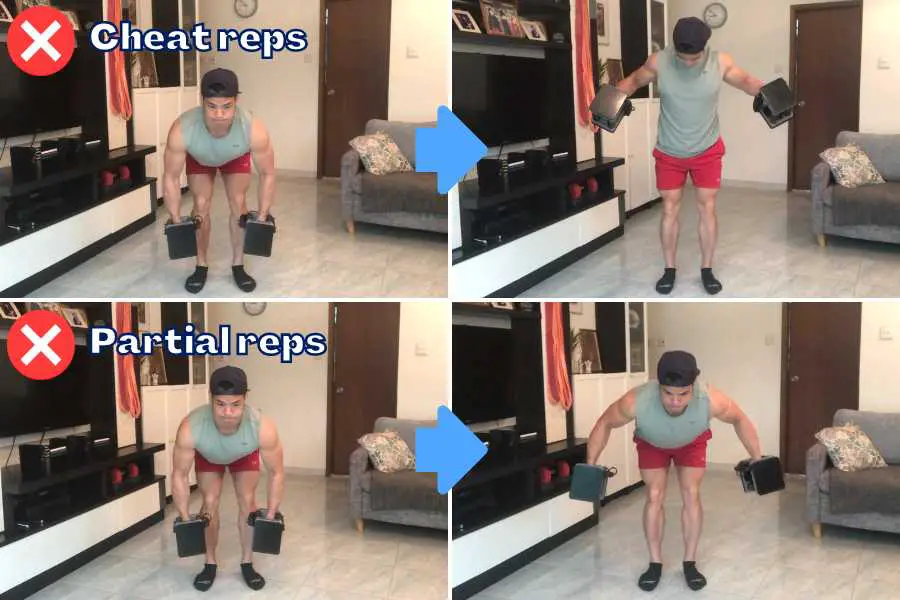
Most people find the reverse dumbbell fly difficult for two reasons:
- Unnatural movement. This movement pattern is not replicated a lot in daily life.
- Underdeveloped rear delts and rhomboids. As a result of the above point.
Therefore it’s essential, especially for beginners, to reduce the weight to a manageable load.
Two things can happen if you use too much weight on the reverse fly:
- Cheat reps. Using body momentum to help you lift the dumbbell.
- Partial reps. Not moving through the full range of motion.
Both of these mistakes will reduce rhomboid and posterior delt activation. As a result, muscle growth and strength gain benefits will be negatively impacted.
Solution:
Start with light dumbbells to perfect your form.
Brace your mid-torso and bend your legs slightly to prevent your hips from opening up and using the momentum generated to help you “swing” the dumbbells upward.
This type of cheat rep defeats the purpose of the exercise; which is to work the rhomboids and posterior delts for growth.
Additionally, move through a full range of motion. This is achieved by bringing the dumbbells all the way up to the furthest point possible before bringing them back down.
For more information, you can check out my other guide on choosing the ideal weight to lift to build muscle.
2) Hyperextended wrists.

A hyperextended wrist is bent too far upwards (revealing the palms).
This should be avoided because it puts excessive strain on the wrists, thereby increasing injury risk and decreasing exercise comfort.
As a result, you won’t be able to lift as much weight or reap the strength-gain benefits of the reverse fly.
And this could be why your reverse fly is not getting stronger or improving.
Solution:
Hold your wrists in a neutral position for the entire duration that you’re performing the reverse dumbbell fly.
This means your wrists should be in line with your forearms, as if you were holding a hammer. They should not be bent backward or forwards.
Beginners looking to get big may also be interested in my other post for a skinny to muscular timeline of expected results.
3) Using body momentum when performing the reverse fly.
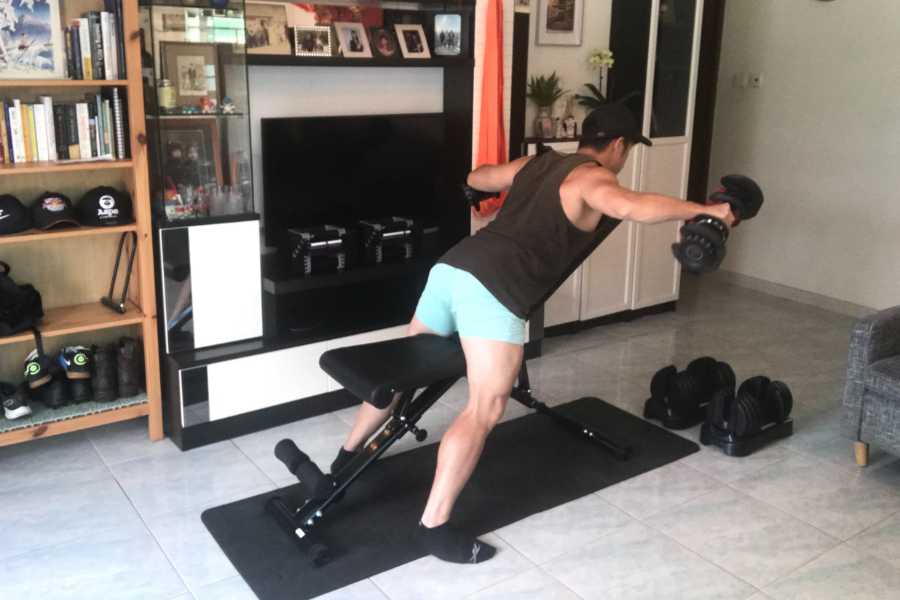
Using body momentum to help you complete an exercise is considered cheating. And cheat reps should be avoided if you’re looking to improve your reverse dumbbell fly.
There are two common ways people cheat:
- Extending the legs and opening your hips.
- Banging the dumbbells together at the bottom of the movement.
Both of these actions will help you generate momentum and make the reverse dumbbell fly easier to perform. But this also decreases muscle activation in the rhomboids and posterior delts.
This is counterproductive if you’re aiming to strengthen the rhomboids and posterior delts, and it may be why you’re finding it difficult to improve your reverse fly.
In fact, lifting with good form and technique is essential for achieving the fastest muscle transformation possible.
Solution:
Bend your legs slightly, brace your core, and keep your back straight and rigid at all times. Make an active effort to not open up your hips as you perform the reverse fly.
For best results, the angle between your hips and thighs should be maintained throughout the movement.
Alternatively, you can sit on a weight bench or a chair. This prevents you from using leg drive to generate momentum, and can really help to maximize target muscle activation.
I use the Flybird FB149 (link for my full review) folding weight bench. It’s affordable and extremely space-saving.
4) Not activating target muscles.
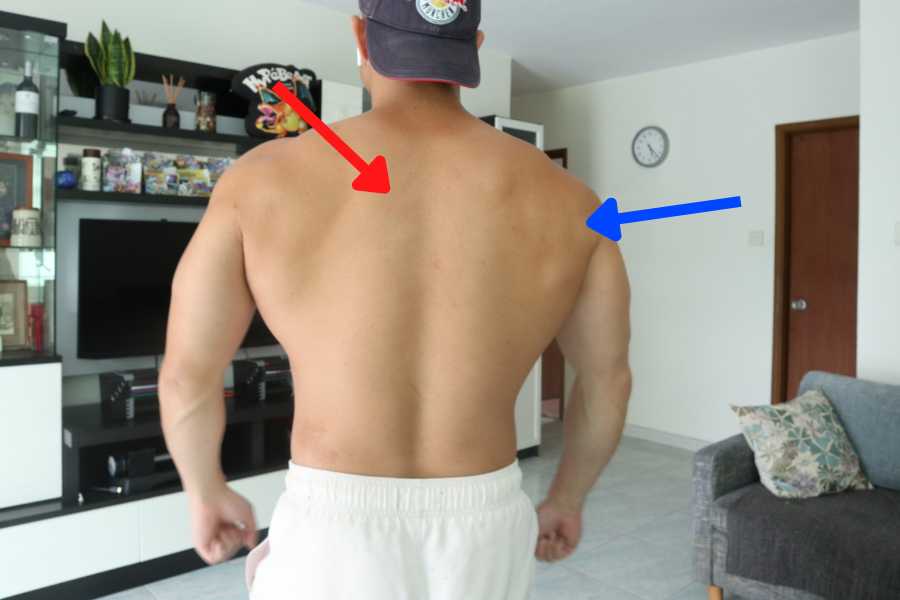
A common mistake beginners make when doing reverse flyes with dumbbells, is focusing too much on the arms and not enough on the back.
Even though the reverse fly works the posterior delts in the rear upper arm/shoulder, remember it is still primarily a back movement working the rhomboids.
If you aren’t activating the back muscles effectively, then you will find the reverse fly more difficult and your strength will be compromised.
Solution:
Actively contract your back to lift the dumbbells up.
A good form cue to implement this is to retract your shoulder blades as you lift the dumbbells, and pinch them together at the top of the exercise.
Additionally, making a conscious effort to contract your back will also help you to develop the mind-muscle contractions required to maximize the weight lifted on the reverse fly.
Beginners may also be interested my other post on the main signs of strength gain. Spotting these signs can help you to determine if you’re doing the exercise correctly.
5) Insufficient calories and protein.

Any successful muscle and strength-building endeavor require some form of bulking diet.
This requires you to eat enough daily calories to fuel growth (hypertrophy), and protein to provide the raw materials to build and repair muscle.
Speaking from research and experience, not going on an effective bulk is one of the most common reasons that people fail to get bigger and stronger.
Solution:
Aim to take in 5-15% more than your daily maintenance calories. Combine this with a protein intake of at least 1g per lb of body weight.
Bulking can be difficult if you’ve never tried it before.
A good way to start is to simply eat more calorie-dense foods such as fatty meats, carbs, and milk.
Additionally, find ways to include more high-protein foods in your diet. Ingredients such as red meat, poultry, and eggs are good examples.
For a complete guide on how to bulk up as a skinny guy, you can check out my home training and dieting routine.
Other Weight Standards For Dumbbell Reverse Fly Muscles
Reverse flyes are a horizontal isolation-type movement that primarily works the rhomboids and posterior deltoids in the mid-upper back and rear shoulder. Here are weight standards for other exercises that hit similar muscle groups:
- Pull-ups– vertical compound pulling exercise with emphasis on the lats and biceps. You might also be interested in the world records for pull-ups!
- Row with dumbbells– horizontal compound pulling exercise that works all back muscles.
- Dumbbell deadlift– full-body compound pulling movement that works all of the back muscles.
- Shoulder press with dumbbells– vertical compound pushing exercise that works all shoulder muscles including the posterior delts.
Conclusion
I’ve shared reverse dumbbell fly weight standards based on my personal 5-years of experience in weight training.
Beginners should be able to do 1 rep using around 5% of their body weight. Intermediates should be able to lift approximately 45% of their body weight, and advanced lifters approximately 75%.
If you’re lifting at or exceeding these strength standards, then you’re doing a good and respectable job.
I’ve also shared common problems and solutions to a reverse fly strength that is below average.
You may also be interested in the downloadable Kalibre Blueprint PDF which details exactly how I gained 40lbs of lean muscle (it’s 100% free!). It details the exact exercises and nutrition (with printables) I used to go from skinny to ripped!

